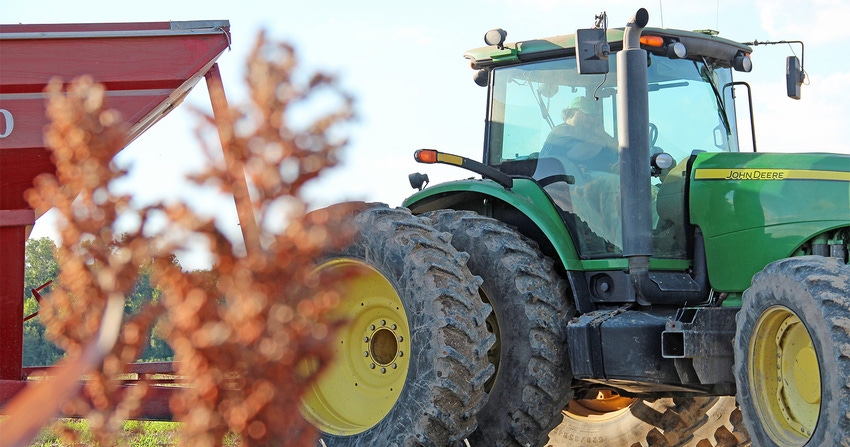
Third in a series of four articles on farm safety and the Farm Safe program.
Transportation accidents, which include tractor and other equipment rollovers, are the leading cause of death for farmers and farm workers, according to the Center for Disease Control and Prevention. The majority of those deaths can be prevented by proper use of safety equipment and training.
The Farm Safe program developed and administered by Agricenter International in Memphis, Tenn., provides a no cost, web-based safety training for the ag/rural community. The program provides a series of safety modules online that can be taken as time allows.
"Safety training is really important," said Pam Robinson. "It's important because after the accident is not the time to get the training, that's too late - the horse is out of the barn at that point."
Equipment operation and maintenance is the leading cause of injury on the farm, Farm Safe provides at least nine modules on use of farm equipment on our farm and ranches.
The farm and rural environment provide a host of opportunities for potential injury. And, although there are safety features installed on most farm equipment, because of a lack of safety training at the farm level those features can lead to accidents.
Tractor operation
Eighty-five percent of tractor rollovers are side rollovers, caused because the tractor's center of gravity is unbalanced. Rollover protection (ROP) can protect operators in those situations, but only if used with a seatbelt to prevent the occupant from being thrown from the tractor.
Making sure the tractor's center of gravity is low to the ground and that loads are not unbalanced are key to preventing rollovers, according to Farm Safe. Other causes of rollovers are driving too fast while turning, driving on a slope, driving with a loaded front-end loader and applying brakes unevenly while traveling at high speeds.
To prevent rollovers, set the tractor wheels as wide as practical, stay away from ditch edges, slopes and streams. Ensuring that counterweights are in place for heavy loads or equipment adds stability and maintains traction.
Slopes can be dangerous. If it can be avoided, do not drive backward down a slope as it may cause the tractor to tumble over backward. Turn around and go forward downhill if possible.
Even a gentle slope can be dangerous. Do not drive diagonally across a slope, in order to avoid rolling.
Use the lowest gear you can while traveling downhill to minimize braking and make sure you stay off the brake and clutch.
All-terrain vehicles
The same is true for all-terrain vehicles (ATVs). Because of their lighter weight and speed, they are more prone to rollovers.
"ATVs have gotten more useful and are more frequently used around the farm," Robinson said. "They are used with livestock as well as getting supplies. They can get into areas where your truck may not be able to get into."
Robinson notes that because they are more accessible, they are more fun.
"But people still need to remember they're not a toy," she said. "There are still important safety issues that must be recognized."
Seatbelts and helmets must be worn to assure rider safety. Distractions must be avoided, including driving under the influence of alcohol or drugs, texting or talking on a cell phone, using headphones to listen to music, fatigue, boredom and just not paying attention.
Part 1: Safety program equips farmers with valuable tools
Part 2: Getting through harvest with a safety plan
It only takes a second for an accident to happen, and if distracted, reaction time may not be enough to avoid an injury, according to the Farm Safe ATV Safety module.
"ATVs and side by sides have become a very valuable tool," said John Butler, President of Agricenter International. "It's also important to be properly trained on ATVs. We encourage everybody to always wear a helmet."
Aside from seatbelts and helmets, safety devices for ATVs should include flags, reflectors, and lights for visibility. A first aid kit, communication devices such as cell phones or two-way radios are also important on the farm.
Passengers should only be taken on ATVs that are equipped with extra seats and seatbelts. Carrying more passengers than the vehicle is built for hampers the driver's ability to operate the vehicle and provides an unnecessary distraction.
Equipment maintenance
Equipment maintenance is also important to ensure safety of ag workers. A well cared for vehicle will not breakdown as often and lessens the opportunity for injury, but vehicle operation is not the only source of hazards.
"There are so many things on the farm that can create hazards for us," Butler said. "PTO shafts, mechanical cutter bars, working under equipment, grain bins, I mean the list of potential hazards goes on and on. It is so important to take a few minutes to help create a culture of safety on out farms."
Farm equipment is built to dig, harvest, pull and move. There are wrap points, shear points, pinch points and crush points involved. The stored energy of pressurized lines, the potential for burns from hot engines and the unexpected object thrown from a piece of equipment are all sources of injury.
Farm Safe recommends the following:
Tag out, lock out procedures are often very important in preventing accidental or unintentional re-energizing of equipment.
Anyone who operates or maintains equipment should be trained on how to control sources of energy, including electrical, mechanical, chemical and hydraulic.
Checklists can help identify problems and safety hazards before anyone is injured or equipment damaged. While performing maintenance or service on equipment, identified all possible safety hazards and prepare for them.
If a safety hazard requires some type of personal protective equipment - safety glasses, heat resistant gloves, or steel toed shoes - make sure to have the right tool for the right job and be fully trained in the use and maintenance of that personal protection equipment.
"It is important to recognize where your safety hazards are," Robinson said. "Make sure that you have a plan if a worst-case scenario or accident impacts your operation. What are you going to do?"
The Farm Safe resource can be found at FarmSafeEveryDay.com. The program is paid for by a grant from the Occupational Safety and Health Administration and the U.S Department of Labor.
About the Author(s)
You May Also Like






